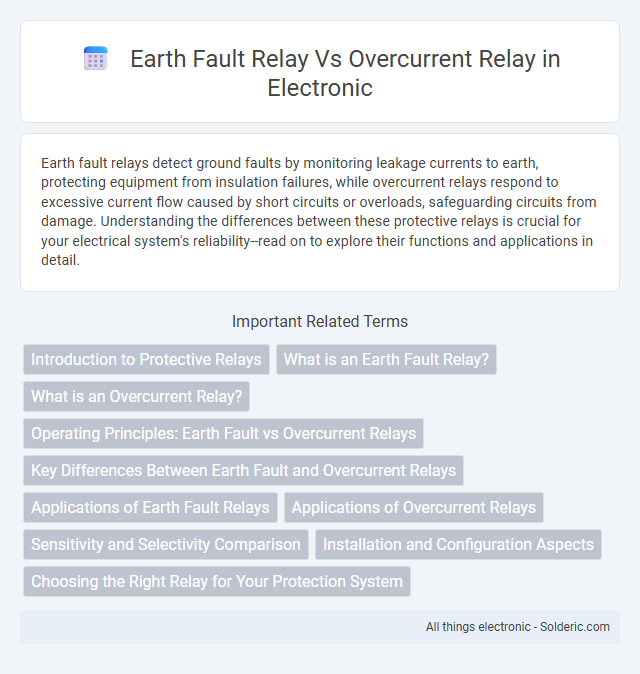Earth fault relays detect ground faults by monitoring leakage currents to earth, protecting equipment from insulation failures, while overcurrent relays respond to excessive current flow caused by short circuits or overloads, safeguarding circuits from damage. Understanding the differences between these protective relays is crucial for your electrical system's reliability--read on to explore their functions and applications in detail.
Comparison Table
| Feature | Earth Fault Relay | Overcurrent Relay |
|---|---|---|
| Function | Detects ground faults or earth leakage currents | Detects excessive current flow beyond set threshold |
| Primary Use | Protects against insulation failure and earth faults | Protects against overload and short circuit conditions |
| Sensitivity | Highly sensitive to low magnitude earth leakage currents | Detects high magnitude overcurrents regardless of fault type |
| Input Signal | Residual or zero sequence current transformer output | Phase current transformer output |
| Typical Setting | Low current threshold, in milliampere or amperes | Higher current threshold, often several amperes |
| Application Example | Ground fault protection in transformers, generators | Overload and short circuit protection in feeders, motors |
| Response Time | Fast to detect earth leakage for quick isolation | Depends on inverse or definite time characteristics |
Introduction to Protective Relays
Protective relays are essential devices in electrical systems designed to detect faults and initiate circuit breaker operation to prevent equipment damage and ensure safety. Earth fault relays specifically detect ground faults by sensing imbalance currents caused by leakage to ground, ensuring protection against earth faults. Overcurrent relays operate by detecting excessive current flow beyond preset limits, safeguarding electrical circuits from overload and short circuit conditions.
What is an Earth Fault Relay?
An Earth Fault Relay detects ground faults by monitoring unbalanced current flow between phase conductors and earth, protecting electrical systems from damage and hazards caused by leakage currents. Unlike overcurrent relays that respond to excessive current in the circuit, Earth Fault Relays specifically identify faults involving earth connections, enhancing safety in installations. You rely on Earth Fault Relays to quickly isolate faulted sections, minimizing equipment damage and preventing electrical fires.
What is an Overcurrent Relay?
An Overcurrent Relay is a protective device designed to detect excessive current flow in electrical circuits, which can result from short circuits or overloads. It operates by measuring current levels and triggering circuit breakers to isolate faults, preventing damage to equipment and ensuring system stability. Unlike Earth Fault Relays that detect ground faults, Overcurrent Relays respond to any current exceeding preset thresholds regardless of fault location.
Operating Principles: Earth Fault vs Overcurrent Relays
Earth fault relays detect earth leakage currents by measuring current imbalances or zero-sequence currents, operating when unintended paths to ground cause fault conditions. Overcurrent relays respond to excessive current flow beyond preset thresholds, protecting circuits from overloads and short circuits by activating upon current magnitudes exceeding set points. Both rely on current sensing but differ in focus: earth fault relays specifically identify ground faults, while overcurrent relays address overall current magnitude abnormalities.
Key Differences Between Earth Fault and Overcurrent Relays
Earth fault relays specifically detect ground faults by sensing current imbalance between the phase and earth, while overcurrent relays respond to any current exceeding a preset threshold regardless of fault type. Earth fault relays enhance the protection of your electrical system by isolating ground faults quickly and minimizing equipment damage, whereas overcurrent relays provide broader protection against overloads and short circuits. Their distinct settings, sensitivity, and application areas delineate their complementary roles in safeguarding electrical networks.
Applications of Earth Fault Relays
Earth fault relays are primarily used to detect ground faults by monitoring leakage currents to earth, ensuring protection in electrical distribution systems where insulation failures or accidental contacts occur. These relays effectively safeguard transformers, generators, and cable networks by isolating faulted sections to prevent equipment damage and enhance system stability. Your electrical system's reliability increases significantly when earth fault relays are integrated alongside overcurrent relays, which mainly address overloads and short circuits.
Applications of Overcurrent Relays
Overcurrent relays are extensively used in electrical protection systems to detect and isolate faults caused by excessive current flow, safeguarding transformers, generators, and distribution lines. They provide critical protection against short circuits, overloads, and phase imbalances by tripping circuit breakers during abnormal current conditions. These relays are essential in industrial plants, substations, and power distribution networks to ensure reliability and prevent equipment damage.
Sensitivity and Selectivity Comparison
Earth fault relays exhibit higher sensitivity than overcurrent relays by detecting low-magnitude fault currents specific to ground faults, enhancing early fault detection. Overcurrent relays prioritize selectivity through setting coordination to isolate faults in targeted zones, reducing unnecessary power disruptions. The combined use of both relays ensures optimal sensitivity for earth faults and precise selectivity for overcurrent conditions in power protection schemes.
Installation and Configuration Aspects
Earth fault relays are typically installed close to the neutral point of transformers or generators to detect ground faults, requiring precise neutral grounding arrangements and sensitivity settings for low-resistance faults. Overcurrent relays are installed in series with the circuit they protect, with configuration involving current transformers and setting time-current characteristic curves tailored to load conditions. Proper coordination between earth fault and overcurrent relay settings is crucial to ensure selective tripping and minimize system downtime.
Choosing the Right Relay for Your Protection System
Selecting the right relay for your protection system depends on the type of fault you need to detect; Earth fault relays specifically monitor ground faults by sensing leakage currents, providing rapid isolation to prevent equipment damage and ensure safety. Overcurrent relays respond to excessive current flow from overloads or short circuits, protecting conductors and equipment by tripping circuits when current exceeds preset thresholds. Understanding the distinct roles and sensitivity of earth fault versus overcurrent relays allows engineers to design comprehensive protection schemes tailored to system requirements and fault characteristics.
Earth fault relay vs overcurrent relay Infographic

 solderic.com
solderic.com